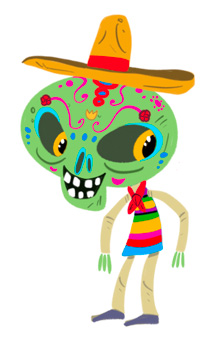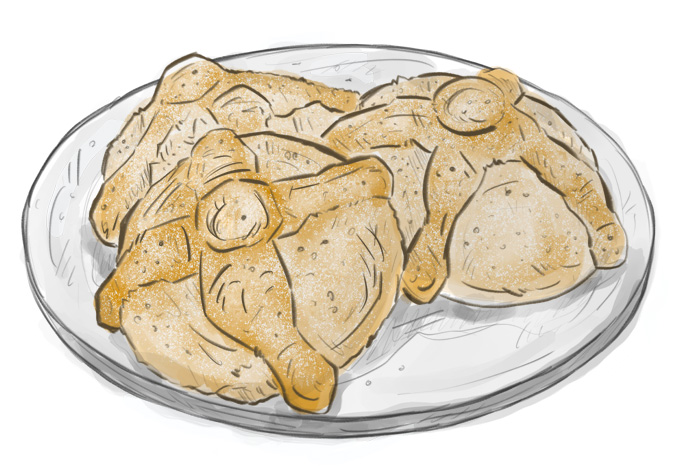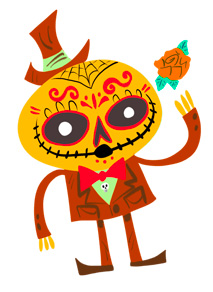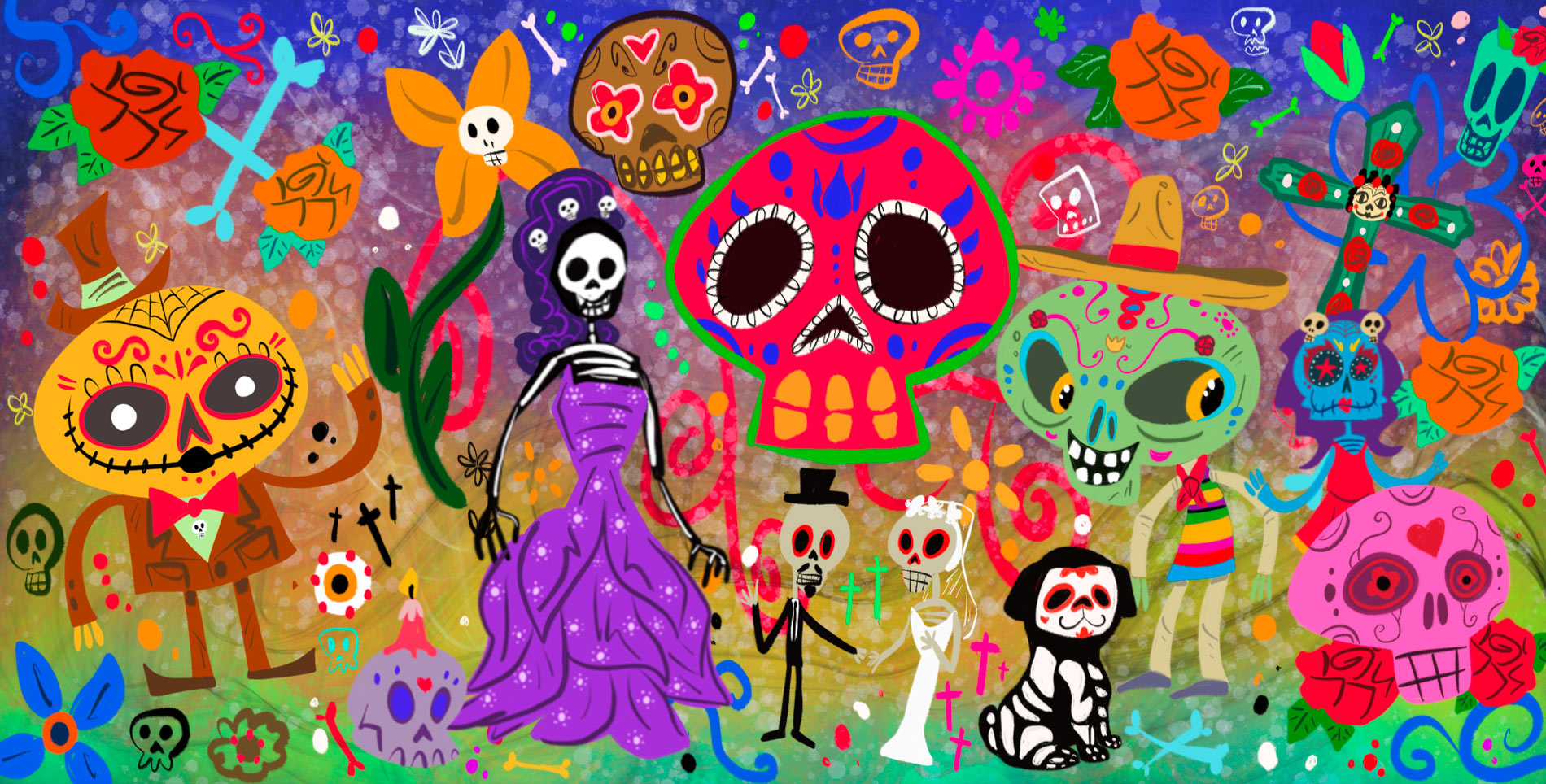Author’s Note: “Ruminate (verb) 1. to chew on, 2. to meditate or muse; ponder.
There is a long and unique story behind every meal, weekend barbecue, and late night snack. Every month, the Ruminations column explores the cultural and social histories of your favorite bites. If you have ever pondered over a plate and considered “who first put these ingredients together” or “where did this dish come from,” these brief history lessons answer the question, “why am I eating this again?”
——
Most people assume prepared food is meant to be eaten. Though it seems fairly logical, this is not the case of Día de los Muertos, a celebration where in Mexico and some parts of the United States, the living to celebrate the dead by preparing for them a meal. Throughout the holiday, which typically runs from October 31 through November 2, the deceased are honored with elaborate meals served as communication between the two worlds. Because for the dead, as it is with the living, food is nourishment.
While Spanish arrival drastically changed and eventually enveloped indigenous cultures, the belief system of pre-Columbian societies has survived in part of an uneasy negotiation with Roman Catholicism. The ways in which the Mayans and Aztecs celebrated their dead withstood the introduction of the Catholic All Saints’ Day and All Souls’ Day (November 1 and 2 respectively), and built the framework for today’s Día de los Muertos festivities.
 One of Día de los Muertos historical threads leads to the Aztec goddess Mictecacihuatl. As ruler of Mictlan (Nahuatl for underworld), she was said to have an affinity for the cempasúchil flower. To appease Mictecacihuatl and cajole the dead back to the realm of the living to celebrate the autumn harvest festival, this yellow flower was placed on altars alongside food, including principal crops as like maize and squash, and ceremonial drinks like maize-based atol. While this Aztec festival presided over the two months of harvest season, aspects of the ritual, specifically the offering of foods and the presence of the soft yellow cempasúchil flower, were incorporated today’s celebrations.
One of Día de los Muertos historical threads leads to the Aztec goddess Mictecacihuatl. As ruler of Mictlan (Nahuatl for underworld), she was said to have an affinity for the cempasúchil flower. To appease Mictecacihuatl and cajole the dead back to the realm of the living to celebrate the autumn harvest festival, this yellow flower was placed on altars alongside food, including principal crops as like maize and squash, and ceremonial drinks like maize-based atol. While this Aztec festival presided over the two months of harvest season, aspects of the ritual, specifically the offering of foods and the presence of the soft yellow cempasúchil flower, were incorporated today’s celebrations.
Yet, it was not just the Aztecs who played a part in shaping how Día de los Muertos is celebrated. The Yucetac Maya held a similar, week long festival that fell between the last week of October and first of November, called Hanal Pixan—which loosely translates to, “food for the souls.” Like the Aztec’s Mictecacihuatl festival, Hanal Pixan contributed to the aesthetics on which Día de los Muertos are built.
 During Hanal Pixan, an altar is erected and filled with traditional foods to aid the departed in their journey to the underworld. The highlight is a dish called mucbipollo, itself a portmanteau of Yucatec and Spanish. Traditionally, this pit baked chicken-and-corn fare is made only during the Hanal Pixan festival, and like other foods prepared during Día de los Muertos, it is a ceremonial dish made specifically for the deceased.
During Hanal Pixan, an altar is erected and filled with traditional foods to aid the departed in their journey to the underworld. The highlight is a dish called mucbipollo, itself a portmanteau of Yucatec and Spanish. Traditionally, this pit baked chicken-and-corn fare is made only during the Hanal Pixan festival, and like other foods prepared during Día de los Muertos, it is a ceremonial dish made specifically for the deceased.
In the Christian pantheon, particularly in the brand of Roman Catholicism that spread across Latin America, bread is highly symbolic when dealing with the death. The sacramental bread represented more than the body of Christ, but the full weight of the Spanish empire in Mesoamerica. While corn held its value as a staple food, bread soon dominated indigenous cuisine, becoming a key aspect in ceremonial and celebratory gatherings.

Pan de Muerto, a sweet bread, is one of the quintessential offerings in contemporary Día de los Muertos celebrations. The presence of this sweetbread during the festival is said to give life to the dead. Historically, Pan de Muerto exists somewhere in the liminal space between fact and myth. Some folk-scholars attribute an early version of this bread to the cultural negotiations of Pre-columbian sacrificial rituals and the newly-arrived Spanish. In such, the Spanish gave Aztecs this bread in lieu of human sacrifice.
Others attribute it specifically to the Basque immigrants that came to Mexico City en masse during the late 1800s, many of whom were millers, bakers and wheat farmers. Within a century, baked goods became part of Mexico’s cultural narrative, with sweetbreads a highlight of celebrations in the country’s syncretic Catholic faith. Ironically, pan dulce, so associated with Mexican cuisine and the forebear to Pan de Muerto, was greatly influenced by Basque sweetbreads.

While leagues away from the Eucharist in this sense, Pan de Muerto is highly symbolic. Affixed atop the round loaf is a small knot and four strips of dough made to resemble a skull and bones. When baked, the knots rise and the result is reminiscent of a headstone or burial mound. Much like the Hanal Pixan and Mictecacihuatl festivals, variations of this bread are made throughout Mexico, but this skull and bones version is the standard in Mexico City and southwestern United States.
In some practices, family members bring Pan de Muerto to the graves of their loved ones; this acts as something of a seance with dearly departed. In others, the bread is the masthead of the altar, the spiritual nourishment for wayward souls. Regardless of how it used or consumed, Pan de Muerto is one dish used as an intermediary between the living and dead. Cooking may be one of humanity’s oldest accomplishments, but sometimes food, and the act of eating it, is way to speak to directly to the past.








Our comments section is for members only.
Join today to gain exclusive access.